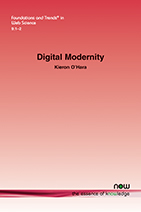Digital Modernity
By Kieron O’Hara, Emeritus Fellow in Electronics and Computer Science, University of Southampton, UK, kmoh@soton.ac.uk
Abstract
“Modernity” is a social, cultural or historical descriptor for a certain type of society or set of social arrangements. This monograph reviews narratives of digital modernity, without endorsing them; as narratives, they selectively discuss aspects of our sociotechnical context, descriptively, teleologically or normatively. Digital modernity narratives focus on the possibilities of the data gathered by an ambient data infrastructure, enabled by ubiquitous devices such as the smartphone, and activities such as social networking and e-commerce. Some emphasise continuities with 20th century modernity narratives, while others emphasise discontinuity, such as theories of the singularity. Digital modernity is characterised by: a subjunctive outlook where people’s choices can be anticipated and improved upon; the valorisation of disruptive innovation on demand; and control provided by data analysis within a virtual realm (cyberspace or the metaverse) which can be extended and applied to the physical world (in such applications as the quantified self and the smart city). The synergies and tensions between these three aspects are explored, as are the opportunities for and dilemmas posed by misinformation. Five principles emerge from the study of relevant texts and business models: (1) the quantity of data being produced in the world has enabled, and been enabled by, technological, social, economic and cultural change, and as such is a marker of a qualitative change in modernity; (2) digital modernity is a subjunctive world in which reflexivity and choice are outsourced to the ambient data infrastructure; (3) since personalisation replaces choice in digital modernity, and since effective personalisation demands knowledge about the individual on the part of the personalised service provider, privacy is now an obstacle to the delivery of digital modernity; (4) to exist is to be backward; (5) the best that hapless reality can achieve is to get closer to the perfection of the algorithm and the data. To conclude, digital modernity is contrasted with other theories of the 21st century information society, including postmodernism, the network society and ANT.
Digital Modernity
“Modernity” is a social, cultural, or historical descriptor for a certain type of society or set of social arrangements. It is a contentious and disputed term, often understood implicitly. It is a way of describing and classifying highly complex, dynamic, and emergent aggregate social phenomena, and so dramatically simplifies such contexts. However, the language of modernity remains attractive to commentators, academics, and policymakers.
In this monograph, the author reviews the literature that characterises what is called digital modernity. Digital modernity narratives focus on the possibilities of the data gathered by an ambient data infrastructure, enabled by ubiquitous devices such as the smartphone, and activities such as social networking and e-commerce. It is characterised by (1) a subjunctive outlook where people’s choices can be anticipated and improved upon, (2) the valorisation of disruptive innovation on demand, and (3) control provided by data analysis within a virtual realm that can be extended and applied to the physical world. The author explored the synergies and tensions between these three aspects as well as the opportunities for and dilemmas posed by misinformation. The author identifies five principles that emerge from the study of relevant texts and business models and concludes by contrasting digital modernity with other theories of the 21st century information society.
Narratives of digital modernity are useful because they help explain the development of technology. It matters because many influential people accept, and often generate, the digital modernity narrative. Given digital modernity’s strong association with the Web, it is a central topic for Web Science as the interdisciplinary study of the World Wide Web from the technological, social, and individual points of view.
